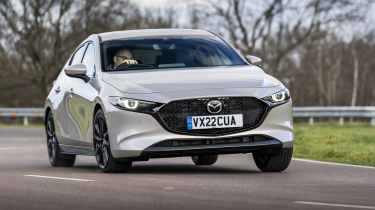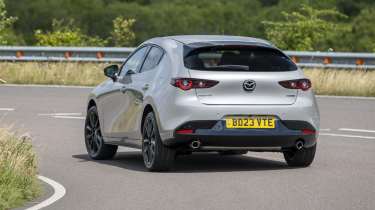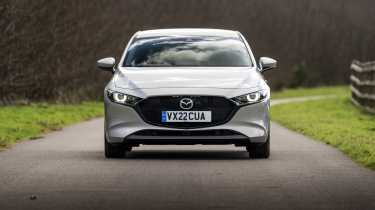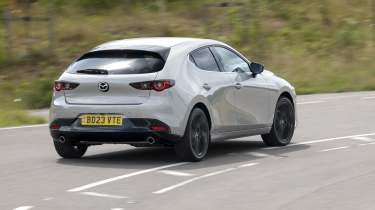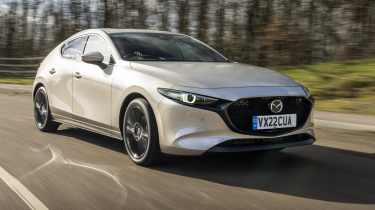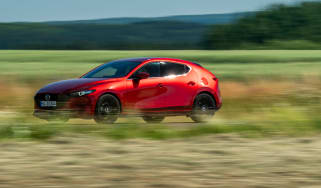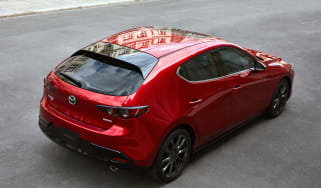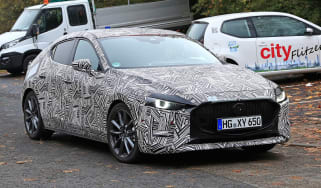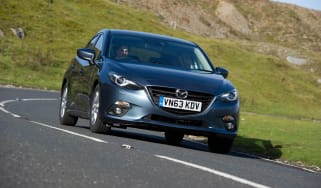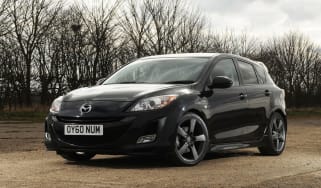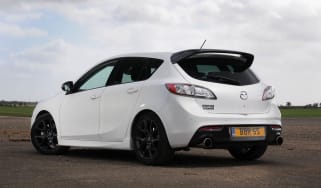Mazda 3 2025 review – a refreshing take on the hatchback formula
Mazda’s innovation has never been more apparent – the Mazda 3 is flawed but brilliant, and the type of ‘normal’ car we need
There’s only so much appeal an everyday family hatchback can possibly have, but the Mazda 3 is actually quite interesting. This is not because of innovative new powertrain tech or lack of forced induction, but because the Mazda 3 has achieved something no mainstream front-wheel-drive hatchback has any right to. It’s desirable.
The distinctive styling is an obvious source of this, and although some people are less than complimentary about it, in the flesh the 3 is distinctive, with plenty of well-thought-out details. In the current market of crowded fascias, fake vents and the notion of ‘sporty’ trim levels, the Mazda’s design is a refreshing one, with a near-perfectly formed aesthetic. Even all these years since its 2019 launch, it looks sharp and modern on the road.
> Mazda CX-80 2025 review – Japan’s six-cylinder SUV eyes BMW X5
It’s by no means perfect – there might be one or two key flaws that keep this car from receiving true widespread acclaim, but as a modern, affordable, desirable family car, in the presence of misguided SUVs and mass platform sharing, the Mazda 3 might just be the type of car we really need.
Engine, performance and 0-62mph time
The Mazda 3 is available with just two engine choices, both now petrol and with the option of a manual or automatic depending on which trim level you choose – a 2.2-litre diesel model was available at its launch, but this has since been pulled from sale in the UK. Opt for the basic Prime-line trim and the 138bhp four-cylinder petrol is all you have to choose from, equipped with a manual transmission. Centre-line trim and above brings a more potent 183bhp variant to the table, with the Homura trim offering the same two engines, only with the choice of either a manual or automatic – the latter comes at a c£1500 premium.
More reviews
Previously, the entry point for the Mazda 3 granted you just 121bhp, making the current 138bhp starting point a welcome addition. Don’t think this makes it quick, though, with even the more potent 183bhp range-topper lacking in the low-end pull we’ve become accustomed to in turbocharged, electrified alternatives (both current engine options are naturally-aspirated). The most powerful engine revs cleanly and to a much higher redline than you might expect, but you have to use a good chunk of them to make any progress. On more than one occasion, it felt as if it had popped out of gear shifting from 1st to 2nd, given the lack of forward drive. Given the revs required, you’re unlikely to see much more than 40mpg either. This engine is best reserved for the MX-5.
Regardless of this, it’s a supremely refined powertrain. At speed, you could be convinced the engine is off entirely, with great in-cabin refinement making it feel more like an EV than an old school, naturally-aspirated hatch – it just lacks the torque associated with them…
Thankfully, Mazda’s swift six-speed manual transmission is a pretty good pairing, with a short throw and accurate gaiting. It’s not quite as deft as the unit found in a Honda Civic, but it’s nice to use nonetheless. The six-speed automatic is of the traditional torque-converter variety, and although it struggles to match a dual-clutch’s shift speed, it’s a much smoother transmission at low speeds, even when compared to VW’s slick wet-clutch DSGs.
Curiously, Mazda will actually let you option a £1200 Sports exhaust system should you want to increase sound output of your everyday hatchback, and if that’s a little too costly, a muffler extension costs just £200.
Ride and handling
Unlike a majority of its rivals, the Mazda 3 ditches a multi-link rear axle in favour of a simple torsion bar. Rather than being a cost-cutting or space-saving decision, the rear axle’s simple set-up has been fitted for the improvement of ‘road feel’. Some might want to call Mazda out on this, but engineers are adamant the reduction of input forces from the rear axle improves front-end feel.
The package is otherwise pretty standard – front-wheel drive is standard in the UK, although other markets do have the option of all-wheel drive. The engine is mounted transversely, with the transmission sitting alongside. The structure is now stiffer than before, and noise levels have also been a focal point of this new model, with far better insulation from road, engine and wind noise.
On the road is where the Mazda 3’s relatively humble underpinnings start to show. It’s refined, but there is a feeling that where a Golf or A-class feel capable of handling three, or even four hundred horsepower, the Mazda’s chassis just lacks that robustness that German rivals have engineered in.
The Mazda 3 is impressively damped, and that torsion bar rear axle doesn’t really make itself known until the road gets really challenging, but there is still notable movement to the body that knocks your confidence to really attack a road. The steering is partly to blame, as it lacks the resolute sharpness of that of a Focus, although it is more trustworthy than the ultra-light helm on a basic Golf. The Mazda’s issue lies instead with its balance, which heavily loads the outside front tyre on turn-in, the body movement almost rolling over the top of you from behind when entering a corner. It’s still a sharper car to drive than most in the class, but the Focus still has the edge.
Turn the pace down and the Mazda’s core ability does reveal itself, as the ride is remarkably settled, while cabin noise suppression is good. The control weights all coincide with one another too, making this a car that requires little time to acclimatise to.
Interior and tech
The interior was a big leap for the Mazda 3 at its launch, with its design, execution and technology streets ahead of not just its predecessor, but just about every other mainstream car at this price point. The surfaces are plush, the shapes dramatic, yet simple. It’s a masterstroke of interior design, and doesn’t only promote the 3 to levels above the Focus and Golf, but one that shows up supposed premium players for interior ambiance. Unlike a Mercedes-Benz A-class, which hides its questionable use of materials behind glossy screen interfaces and an overuse of coloured ambient lighting, the 3 is finely wrought, with materials equivalent to those in Audis and Volvos.
There is real substance here too. The seating position is good, the seats themselves superbly supportive and comfortable, and each digital interface perfectly formed and complementary of its surroundings. The infotainment system is sharp and responsive, and while it lacks the depth of capability of something like Mercedes’ MBUX system, it’s a strong offering and does everything you’ll likely need it to. The screen is low and wide, but perfectly formed.
The cabin feels relatively small, with the scuttle high, but it feels cosseting and premium. Everything from the door handles to the thin-rimmed steering wheel and the gear shift feel well considered, with all touch points solid. The physical buttons (of which there are plenty) are satisfying and tactile, with elements such as the indicator sound thoughtfully chosen – it’s just a shame the driver assistance systems constantly disrupt the quiet cabin with more warnings than most (there is a way to disable these sounds with a single button press, but it’s frustrating regardless).
The entry-level car comes only with cloth seats, but Homura trim (priced from £26,060) brings better upholstery to the table, along with improved standard interior tech such as wireless charging and USB-C ports.
Price and rivals
The Mazda 3 starts from £24,460 in 2025, and while that’s almost £4000 more than when it first hit the market, it’s still a well-priced offering. The Hyundai i30 is the closest match at £24,525, but the Ford Focus costs more at £28,500, with more premium offerings like the Mercedes-Benz A-class and Audi A3 priced from £31,020 and £30,100 respectively.
The Mazda 3 range begins with the entry-level Prime-line trim, giving you 16-inch wheels and cloth seats for that £24,460 figure. Further up the range, the Homura trim brings 18-inch wheels, uprated upholstery and interior tech to the equation for £26,060, with the £29,660 range-topper with the most standard kit of the lot. The most expensive Mazda 3 before options, the Takumi with the 183bhp automatic powertrain, will set you back just £33,705 before options, impressive given the £30,000 starting price of its 'premium' German rivals.
If there is a Mazda 3 that fits your requirements, you will not be disappointed. It’s not perfect, it’s not the most practical, nor the most fun to drive, but it is clear that Mazda’s focus with the 3 was incredibly clear and concise. Pack in a more talented powertrain, maybe some extra precision to the chassis, and the 3 might just be a winner.
